Kenmore 795.77319.600, 795.77316.600, 795.77314.600, 795.77312.600, 795.77309.600 Service Manual
...
R
BOTTOM FREEZER REFRIGERATOR
REFRIGERATOR
SERVICE MANUAL
CAUTION
BEFORE SERVICING THE PRODUCT
READ THE SAFETY PRECAUTIONS IN THIS MANUAL
ENGLISH
795.77302.600/601
795.77304.600/601
795.77306.600/601
795.77309.600/601
795.77312.600/601
795.77314.600/601
795.77316.600/601
795.77319.600/601
Sears, Roebuck and Co., Hoffman Estates, IL60179 U.S.A. |
www.sears.com |

CONTENTS
SAFETY PRECAUTIONS .......................................................................................................... |
2 |
1. SPECIFICATIONS .................................................................................................................. |
3 |
2. PARTS IDENTIFICATION ....................................................................................................... |
5 |
3. DISASSEMBLY ...................................................................................................................... |
6 |
3.1 Door .................................................................................................................................. |
6 |
3.2 Door alignment ............. .................................................................................................... |
7 |
3.3 Fan and fan motor .............................................................................................................. |
8 |
3.4 Defrost control assembly ................................................................................................... |
8 |
3.5 Lamp ................................................................................................................................. |
8 |
3.6 Refrigerator control box ..................................................................................................... |
8 |
3.7 Multi duct ........................................................................................................................... |
8 |
3.8 How to remove and reinstall the pullout drawer ................................................................... |
9 |
3.9 Cover Valve ....................................................................................................................... |
12 |
4. COMPRESSOR ELECTRICAL ............................................................................................. |
13 |
4.1 Compressor ...................................................................................................................... |
13 |
4.2 PTC-Starter ....................................................................................................................... |
13 |
4.3 OLP (overload protector) ................................................................................................... |
14 |
4.4 To remove the cover PTC ....................... ........................................................................... |
14 |
5. CIRCUIT DIAGRAM ............................................................................................................... |
15 |
6. TROUBLESHOOTING ........................................................................................................... |
17 |
6.1 Compressor and electrical components ............................................................................. |
17 |
6.2 PTC and OLP .................................................................................................................... |
18 |
. 6.3 Other electrical components .............................................................................................. |
19 |
6.4 Service diagnosis chart ...................................................................................................... |
20 |
6.5 Refrigeration cycle ............................................................................................................. |
21 |
7. ICEMAKER OPERATING PRINCIPLES AND REPAIR .......................................................... |
23 |
7.1 Operation Principle ............................................................................................................ |
23 |
. 7.2 Ice maker functions ............................................................................................................ |
24 |
7.3 Defect diagnosis function ................................................................................................ |
25 |
8. DESCRIPTION OF FUNCTION & CIRCUIT OF MICOM ......................................................... |
26 |
8.1 Function ............................................................................................................................ |
26 |
8.2 PCB function ..................................................................................................................... |
31 |
8.3 Resistance specification of sensor ..................................................................................... |
32 |
8.4 Troubleshooting ................................................................................................................ |
33 |
8.5 Main PWB assembly and parts list ..................................................................................... |
35 |
8.6 PWB diagram .................................................................................................................... |
37 |
9. EXPLODED VIEW AND REPLACEMENT PART LIST ........................................................... |
41 |
795.773**.600 ......................................................................................................................... |
46 |
795.773**.601 ......................................................................................................................... |
54 |
SAFETY PRECAUTIONS
Please read the following instructions before servicing your refrigerator.
1.Check the refrigerator forcurrent leakage.
2.To prevent electric shock,unplug before servicing.
3.Always check line voltage and amperage.
4.Use standard electrical components.
5.Don't touch metal products in the freezer with wet Hands.This may cause frost bite.
6.Prevent water from spiling onto electrical components Or the Machine parts.
7.Before tilting the refrigerator,remove all materials from On or in the refrigerator.
8.When servicing the evaporator,wear gloves to prevent Injuries from the sharp evaporator fins.
9.Service on the refrigerator should be performed by a Qualified technician.Sealed system repair must be Performed by a CFC certified technician.
-2-

1. SPECIFICATIONS
1-1 DISCONNECT POWER CORD BEFORE SERVICING IMPORTANT: RECONNECT ALL GROUNDING DEVICES.
All parts of this appliance capable of conducting electrical current are grounded. If grounding wires, screws, straps, clips, nuts or washers used to complete a path to ground are removed for service, they must be returned to their original position and properly fastened.
1-2 IMPORTANT NOTICE
This information is intended for use by individuals possessing adequate background |
of electrical, electronic and mechanical experience. |
Any attempt to repair a major appliance may result in personal injury and property damage. The manufacturer or seller cannot be |
|
responsible for the interpretation of this information, nor can it assume any liability in connection with its use. |
|
1.3 ELECTR IC AL SPECIFIC ATIO N S |
|
Freezer Temperature Control (Middle setting) ................................................................................................................... |
-6°F to +8°F |
Defrost Control ................................................................................................................................................................................... |
Automatic |
Defrost Thermostat ..................................................................................................................................................................................... |
50°F |
Electrical Rating : 115VAC, 60Hz............................................................................................................................................................... |
1- 5 A |
Maximum Current Leakage ..................................................................................................................................................................... |
0.5mA |
Maximum Ground Path Resistance .................................................................................................................................................. |
0.14 Ohms |
Energy Consumption.................................................................................................................................... |
22 cu.ft. 493 kWh/yr (Energy Star) |
1-4 NO LOAD PERFORMANCE |
|
|
C o n tro l P o s itio n : M ID /M ID |
|
|
And Ambient of: |
70°F |
90°F |
Fresh Food, °F............................................................... |
33°F to 41°F ...................................................................................... |
33°F to 41°F |
Frozen Food, °F.............................................................. |
-4°F to +4°F ...................................................................................... |
-4°F to +4°F |
Percent Running Time........................................................ |
25%-35% ....................................................................................... |
....45%-60% |
1-5 REFRIGERATION SYSTEM |
|
1-6 INSTALLATION |
|
Minimum Compressor Capacity Vacuum |
...................................21 in |
Clearance must be provided at top, sides and rear of the refrigerator |
|
Minimum Equalized Pressure |
49PSIG |
for air circulation. |
|
@70°F...................................................................... |
AT TOP |
1 in |
|
@90°F...................................................................... |
56PSIG |
||
Refrigerant R134a................................................................. |
4 . 2 oz |
AT SIDES.................................................................................. |
1/8 in |
Compressor ................................................................... |
700 BTU/hr |
AT REAR....................................................................................... |
1 in |
- 3 -

PERFORMANCE DATA
(NORMAL OPERATING CONDITIONS)
AMB |
WATTS |
SYSTEM PRESSURE (PSIG) |
|||
HIGH SIDE |
LOW SIDE |
||||
|
|
|
|||
70°F |
98 (+10 |
/ -10) |
98 (+5 / -3) |
(-5) to (-2) |
|
90°F |
98 (+10 |
/ -10) |
132 (+3 / -3) |
(-4) to 1 |
|
110°F |
103 (+5 |
/ -5) |
180 (+5 / -5) |
(-2) to 3 |
|
|
|
|
|
|
|
1-7 REPLACEMENT PARTS
Relay ................................... |
EBG32606502 |
Overload ............................... |
6750C-0004S |
Defrost Thermostat ............... |
6615JB2005C |
Defrost Heater ....................... |
5300JB1100J |
Evaporator fan motor ............ |
4681JK1004A |
Capacitor .............................. |
0CZZJB2012J |
Compressor (Hi-Side) .......... |
2521CRA5715 |
Evaporator (Lo-Side) ............. |
5421JJ1001B |
Condenser ............................ |
5403JJ1007A |
Dryer ...................................... |
5851JJ2002F |
Condenser fan motor ............. |
4681JB1029J |
Temperature Control ............. |
6871JB1374C |
Main Control .......................... |
6871JK1011A |
1-8 AIR FLOW / CIRCULATION D’AIR.

















 EVAPORATOR EVAPORATOR FAN
EVAPORATOR EVAPORATOR FAN 









FRESH FOOD
COLD AIR
MIXED AIR
AIR RETURN TO EVAPORATOR
Vegetable box
HOT LOOP
DRYER |
EVAPORATOR |
CONDENSER FAN |
FREEZER |
COMPRESSOR CONDENSER
- 4 -
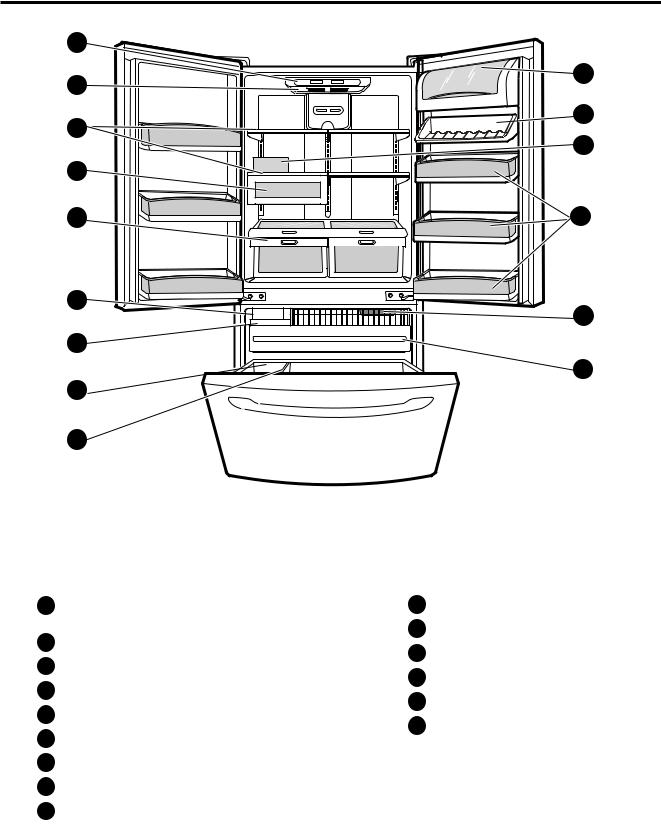
2. PARTS IDENTIFICATION
A |
|
|
B |
O |
|
|
||
C |
N |
|
M |
||
|
||
D |
|
|
E |
L |
|
F |
K |
|
|
||
G |
|
|
H |
J |
|
|
||
I |
|
Use this section to become more familiar with the parts and features.
NOTE:This guide covers several different models.The refrigerator you have purchased may have some or all of the items listed below.The locations of the features shown below may not match your model.
A |
Cool Sense Electronic Temperature |
J |
Glide-Out Drawer Basket |
|
|
Control System |
K |
Freezer Light |
|
B Refrigerator Light |
||||
L |
Modular Door Bins |
|||
|
|
|||
C Refrigerator Shelves
M Egg Box
D Snack Pan
N Can Rack*
E Supra Fresh Crisper with Tilt-Out Compartment
O Dairy Corner
FAdjusta Cube Ice Maker
GIce Bin
HDurabase
I Divider
*On some models
- 5 -
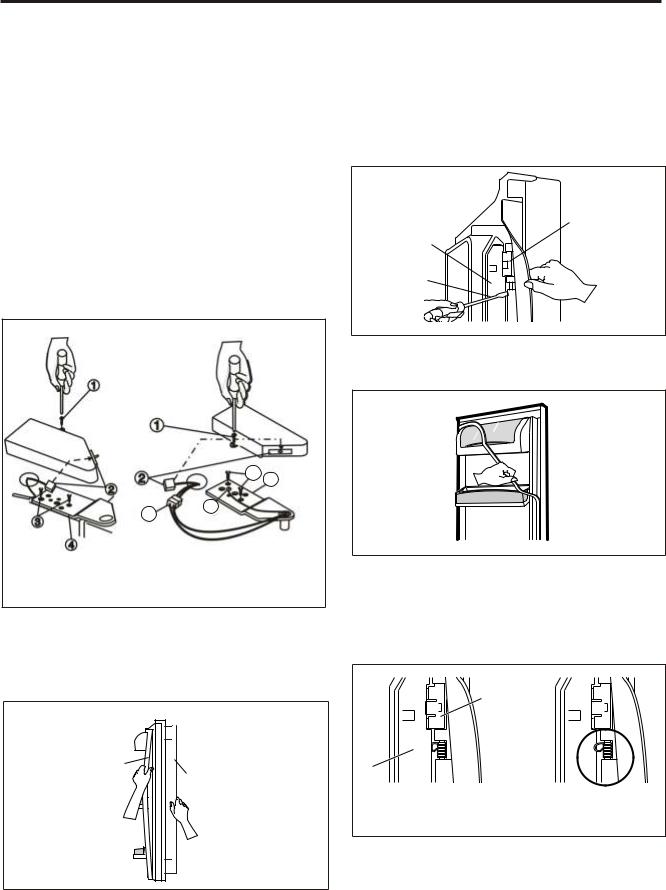
3. DISASSEMBLY
3-1 DOOR
 Left Door
Left Door
 Loosen the cover screw (1).
Loosen the cover screw (1).
 Disconnect door switch wire (2).
Disconnect door switch wire (2).
 Loosen hinge bolts (3).
Loosen hinge bolts (3).
 Lift off the top hinge (4).
Lift off the top hinge (4).
 Place the door on a non-scratching surface with the inside up.
Place the door on a non-scratching surface with the inside up.
 Right Door
Right Door
 Loosen the cover screw (1).
Loosen the cover screw (1).
 Disconnect door switch wire (2).
Disconnect door switch wire (2).
 Disconnect wire harness (3).
Disconnect wire harness (3).
 Loosen hinge bolts (4).
Loosen hinge bolts (4).
 Loosen ground screw (5).
Loosen ground screw (5).
 Lift off the top hinge (6).
Lift off the top hinge (6).
 Place the door on a non-scratching surface with the inside up.
Place the door on a non-scratching surface with the inside up.
4
6
5
3
Left |
Right |
|
Figure 1 |
Door Gasket Removal
1.Remove door frame cover
Starting at top of cover and working down, snap cover out and away from door.
Frame Cover
Handle
Figure 2
2. Remove gasket bracket clips
There are two clips on each door. Start bracket removal near one of the middle clips.
1)Pull gasket back to expose gasket bracket clip and door frame.
2)Insert a flat tip screwdriver into seam between gasket bracket and door frame and pry back until clips snap out.
3)Continue prying back along seam until all clips snap out.
Gasket
Door Bracket Clip
Frame
Figure 3
Flat Tip
Screwdriver
 Gasket
Gasket
Bracket
3. Remove gasket
Pull gasket free from gasket channel on the three remaining sides of door.
Figure 4
Door Gasket Replacement
1.Insert gasket bracket clips
1)Insert gasket bracket edge beneath door frame edge.
2)Turn upper gasket bracket spring so that both spring ends are in the door channel.
3)Push in clip until you hear it snap securely into place.
Gasket
Bracket Clip
 Spring
Spring
Door
Frame
Correct |
Incorrect |
Figure 5
4)Push in remaining two clips until you hear each snap securely into place.
Note: Make sure that no part of gasket bracket edge Protrudes from beneath door frame edge.
- 6 -

2. Insert gasket into channel
1) Snap gasket assembly into the door bracket.
Inserting the Gasket Assembly into the Bracket Door.
Correct
Incorrect
Figure 6
2)Press gasket into channel on the three remaining sides of door.
Figure 7
3. Replace door frame cover
Starting at top of cover and working down, snap the cover
back into door.
Figure 8
3-2 DOOR ALIGNMENT
If the space between your doors is uneven, follow the instructions below to align the doors:
1.With one hand, lift up the door you want to raise near the middle hinge.
2.With other hand, use pliers to insert snap ring at the middle hinge as shown.
3.Insert additional snap rings until the doors are aligned. (Three snap rings are provided with the product.)
Figure 9
- 7 -

3-3 FAN AND FAN MOTOR
1.Remove the freezer shelf. (If your refrigerator has an icemaker, remove the icemaker first)
2.Remove the plastic guide for slides on left side by unscrewing phillips head screws.
3.Remove the grille by removing one screw and pulling the grille forward.
4.Remove the Fan Motor assembly by loosening 2 screws.
5.Pull out the fan and separate the Fan Motor and Bracket.
FAN MOTOR
BRACKET
MOTOR
FAN
Figure 11
GRILLE
3-4 DEFROST CONTROL ASSEMBLY
Defrost Control assembly consists of Defrost Sensor and FUSE–M.
The Defrost Sensor works to defrost automatically. It is attached to the metal side of the Evaporator and senses its Temperature.
Fuse-M is a safety device for preventing over-heating of the evaporator area when defrosting.
At 72°C, it turns the Defrost Heater off.
1.Pull out the grille assembly. (Figure 12)
2.Separate the connector with the Defrost Control assembly and replace the Defrost Control assembly
after cutting the tie wrap. (Figure 13)
3.Be sure to retie the wires when reassembling after service.
GRILLE ASSEMBLY |
DEFROST-CONTROL |
|||||||||||||||||||
|
|
|
|
|
|
ASSEMBLY |
||||||||||||||
|
|
|
|
|
|
|
|
|
|
|
|
|
|
|
|
|
|
|
|
|
|
|
|
|
|
|
|
|
|
|
|
|
|
|
|
|
|
|
|
|
|
|
|
|
|
|
|
|
|
|
|
|
|
|
|
|
|
|
|
|
|
|
|
|
|
|
|
|
|
|
|
|
|
|
|
|
|
|
|
|
|
|
|
|
|
|
|
|
|
|
|
|
|
|
|
|
|
|
|
|
|
|
|
|
|
|
|
|
|
|
|
|
|
|
|
|
|
|
|
|
|
|
|
|
|
|
|
|
|
|
|
|
|
|
|
|
|
|
|
|
|
|
|
|
|
|
|
|
|
|
|
|
|
|
|
|
|
|
|
|
|
|
|
|
|
|
|
|
|
|
|
|
|
|
|
|
|
|
|
|
|
|
|
|
|
|
|
|
|
|
|
|
|
|
|
|
|
|
|
|
|
|
|
|
|
|
|
|
|
Figure 12 |
Figure 13 |
3-5 LAMP
Figure 14
3-5-1 Refrigerator Compartment Lamp
1.Unplug Refrigerator, or disconnect power at the circuit breaker.
2.If necessary, remove top shelf or shelves.
3.Release the hooks on both ends of the lamp shield and pull the shield downward to remove it.
4.Turn the lamp counterclockwise.
5.Assembly is the reverse of disassembly. Replacement bulb must be the same specification as the original (Max. 60 W, 2 EA).
Figure 15
3-5-2 Freezer Compartment Lamp
1.Unplug Refrigerator, or disconnect power at the circuit breaker.
2.Release the hooks at back of light cover and pull the cover down to remove it. (Figure 15)
3.Turn the lamp counterclockwise.
4.Assembly is in the reverse order.
Replacement bulb must be the same specification as the original. (Max 60W)
3-6 REFRIGERATOR CONTROL BOX
1.First, remove all shelves in the refrigerator, than remove the Refrigerator control Box by loosening 2 screws.
CONTROL BOX
COVER LAMP
Figure 16
2.Remove the Refrigerator Control Box by pulling it downward.
3.Disconnect the lead wire on the right position and separate the lamp sockets.
3-7 MULTI DUCT
1. Remove the upper and lower caps by using a flat screwdriver, and remove 2 screws. (Figure 17)
2. Disconnect the lead wire on the bottom position.
Figure 17
- 8 -
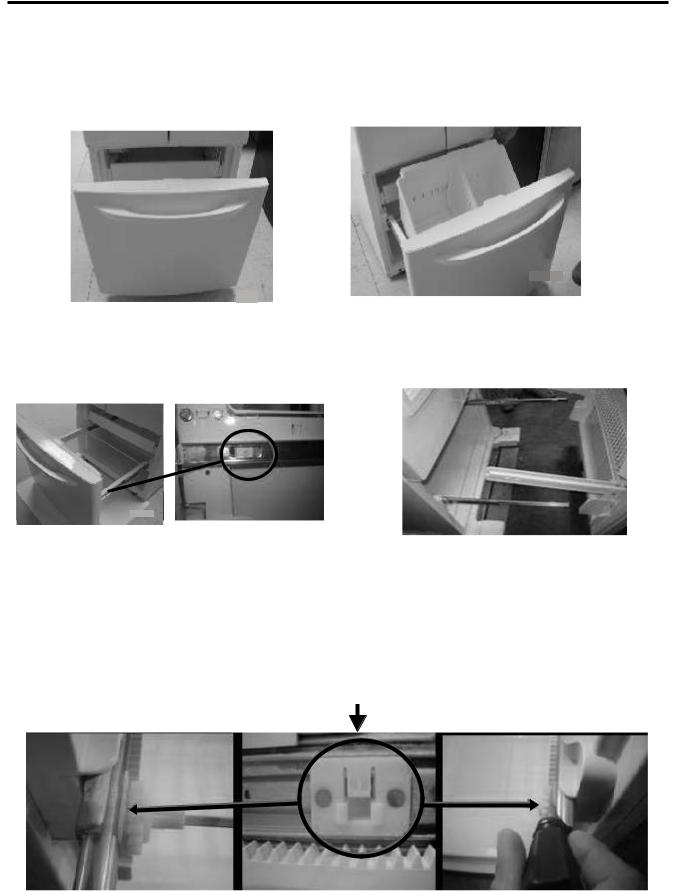
3-8 HOW TO REMOVE AND REINSTALL THE PULL OUT DRAWER
3-8-1 FOLLOW STEPS TO REMOVE
Step 1) Open the freezer door. |
Step 2) Remove the lower basket. |
Step 3) Remove the two screws from the guide rails (one from each side).
Step 4) Lift the freezer door up to unhook it from the rail support and remove.
Pull both rails to full extension.
Step 5) First: Remove the gear from the left side first by releasing the tab behind the gear, place a screwdriver between the gear and the tab and pull up on the gear.
Second: Remove the center rail.
Third: Remove the gear from the right side by following the same steps for the left side.
NOTE: THIS TAB MUST BE PUSHED IN TO RELEASE THE GEAR.
- 9 -

3-8-2 FOLLOW STEPS TO REINSTALL
Step 1) Reinstall the right side gear into the clip.
Step 2) Insert the rail into the right side gear. Gears do not need to be perpendicular to each other.
Step 4) The rail system will align itself by pushing the rails all the way into the freezer section.
Pull the rails back out to full extension.
Step 6) Reinstall the two screws into the guide rails (one from each side).
Step 3) Insert the rail into the left side gear, and insert the gear into the clip.
Step 5) Reinstall the freezer door by inserting the rail tabs into the guide rail.
Step 7) Reinstall the lower basket, and close the freezer door.
- 10 -

3.8.3 GLIDE-OUT DRAWER BASKET
1. To remove, lift basket up and pull out straight out.
1
2
2.To Install, pull both rails out to full extension.
Hook the basket supports into the rail tabs and push to the back of compartment.
- 11 -

3-9 Cover Valve |
- Assemble |
- Disassemble |
|
|
|
1. Push to inside the cover valve.
1. Insert the cover valve as shown in the picture, push to insert (may need force).
a |
b |
2. Push to the right and release.
a |
|
b |
|
|
|
2. Insert hook a & b
3. Release hook a & b |
|
|
|
3. Push to the right to insert the cover valve. |
||
|
|
|
|
|
|
|
|
|
|
|
|
|
|
4. Turn the cover valve 120° as shown in the picture, then release it.
4. Then push to inside to assembly.
- 12 -

4. COMPRESSOR ELECTRICAL
4-2-3 PTC-Applied Circuit Diagram
4-1-1 Role |
•Starting Method for the Motor |
|
|
||
The compressor intakes low temperature and low pressure |
|
|
|
|
|
gas from the evaporator of the refrigerator and compresses |
OVERLOAD PROTECTOR |
|
|
|
|
this gas to high-temperature and high-pressure gas. It then |
|
|
|
||
|
|
|
|
||
delivers the gas to the condenser. |
N |
C |
|
|
|
4-1-2 Composition |
|
|
|
||
PTC |
|
COMPRESSOR |
|||
The compressor includes overload protection. The PTC |
5 |
||||
2 |
MOTOR |
|
|||
starter and OLP (overload protector) are attached to the |
|
|
|
||
|
S |
M |
|
||
outside of the compressor. Since the compressor is |
|
M |
|||
|
S |
||||
manufactured to tolerances of 1 micron and is hermetically |
3 |
6 |
|||
|
|
||||
sealed in a dust and moisture-free environment, use |
L1 |
|
|
|
|
|
|
SEALED |
|
||
extreme caution when repairing it. |
PTC STARTER |
|
|||
4-1-3 Note for Usage |
Resistance Starter Capacitor Running |
TERMINAL |
|||
|
|
||||
(1) Be careful not to allow over-voltage and over-current. |
Figure 17 |
||
(2) If compressor is dropped or handled carelessly, poor |
|
|
|
|
|
||
operation and noise may result. |
4-2-4 Motor Restarting and PTC Cooling |
||
(3) Use proper electric components appropriate to the |
|||
(1) It requires approximately 5 minutes for the pressure, to |
|||
particular compressor in your product. |
|||
equalize before the compressor can restart. |
|||
(4) Keep compressor dry. |
|||
(2) The PTC device generates heat during operation. |
|||
If the compressor gets wet (in the rain or a damp |
|||
Therefore, it must be allowed to cool before the |
|||
environment) and rust forms in the pin of the Hermetic |
|||
compressor can restart. |
|||
Terminal, poor operation and contact may result. |
|||
4-2-5 Relation of PTC-Starter and OLP |
|||
If the hermetic connector rusts out or fails, refrigerant |
|||
and oil will be expelled into the contact area, probably |
(1) If the compressor attempts to restart before the PTC |
||
resulting in smoke and fire. |
device is cooled, the PTC device will allow current to |
||
(5) When replacing the Compressor, be careful that dust, |
|||
flow only to the main winding. |
|||
humidity, and soldering flux don’t contaminate the inside |
|||
(2) The OLP will open because of the overcurrent |
|||
of the compressor. Contamination in the cylinder may |
|||
condition. This same process will continue (3 to 5 |
|||
cause noise, improper operation or even cause it to |
|||
times) when the compressor attempts to restart until |
|||
lock up. |
|||
the PTC device has cooled. The correct OLP must be |
|||
4-2 PTC-STARTER |
|||
properly attached to prevent damage to the |
|||
4-2-1 Composition of PTC-Starter |
compressor. |
||
Parts may appear physically identical but could have |
|||
(1) PTC (Positive Temperature Coefficient) is a no-contact |
|||
different electrical ratings. Replace parts by part |
|||
semiconductor starting device which uses ceramic |
number and model number. Using an incorrect part |
||
material consisting of BaTiO3. |
could result in damage to the product, fire, injury, or |
||
(2) The higher the temperature is, the higher the resistance |
possibly death. |
||
value. These features are used as a starting device for |
4-2-6 Note for Using the PTC-Starter |
||
the motor. |
|||
(1) Be careful not to allow over-voltage and over-current. |
|||
4-2-2 Role of PTC-Starter |
|||
(2) Do not drop or handle carelessly. |
|||
(1) The PTC is attached to the sealed compressor and is |
(3) Keep away from any liquid. |
||
used for starting the motor. |
|||
If liquid such as oil or water enters the PTC, |
|||
(2) The compressor is a single-phase induction motor. |
|||
PTC materials may fail due to breakdown of their |
|||
Durign the starting operation, the PTC allows current |
|||
insulating capabilities. |
|||
flow to both the start winding and main winding. |
|||
(4) If the exterior of the PTC is damaged, the resistance |
|||
|
|||
3) As the compressor starts, the current through the PTC |
value may be altered. This can cause damage to the |
||
compressor and result in a no-start or hard-to-start |
|||
causes its temperature to rise, and so the resistance |
|||
condition. |
|||
|
|||
also rises. When the resistance reaches a high enough (5) Always use the PTC designed for the compressor and |
||
level, only a trickle current will be running through the |
make sure it is properly attached to the compressor. |
|
start winding. This small current then keeps the PTC |
||
Parts may appear physically identical but could have |
||
hot and the resistance high. |
||
different electrical ratings. Replace parts by part |
||
number and model number. Using an incorrect part could result in damage to the product, fire, injury, or possibly death.
- 13 -

4-3 OLP (OVERLOAD PROTECTOR)
4-3-1 Definition of OLP
(1)OLP (OVERLOAD PROTECTOR) is attached to the compressor and protects the motor by opening the circuit to the motor if the temperature rises activating the bimetal spring in the OLP.
(2)When high current flows to the compressor motor, the bimetal works by heating the heater inside the OLP, and the OLP protects the motor by cutting off the current flowing to the compressor motor.
4-3-2 Role of the OLP
(1)The OLP is attached to the sealed compressor used for the refrigerator. It prevents the motor coil from being started in the compressor.
(2)For normal operation of the OLP, do not turn the adjust Screw of the OLP in any way.
4-4 TO REMOVE THE COVER PTC
1) Remove the back cover of the mechanical area.
(OVERLOAD PROTECTOR cross section) |
|
|
||
|
|
Customer part |
|
|
|
12345678 |
number |
|
|
|
Lot code/ |
|
|
|
|
|
|
|
|
330 FBYY |
-S1 BOX98 |
date code |
1 |
3 |
|
||||
Electrical |
|
Physical |
||
characteristics |
|
termination |
|
|
part number |
|
part number |
|
|
2
Figure 18
- 14 -
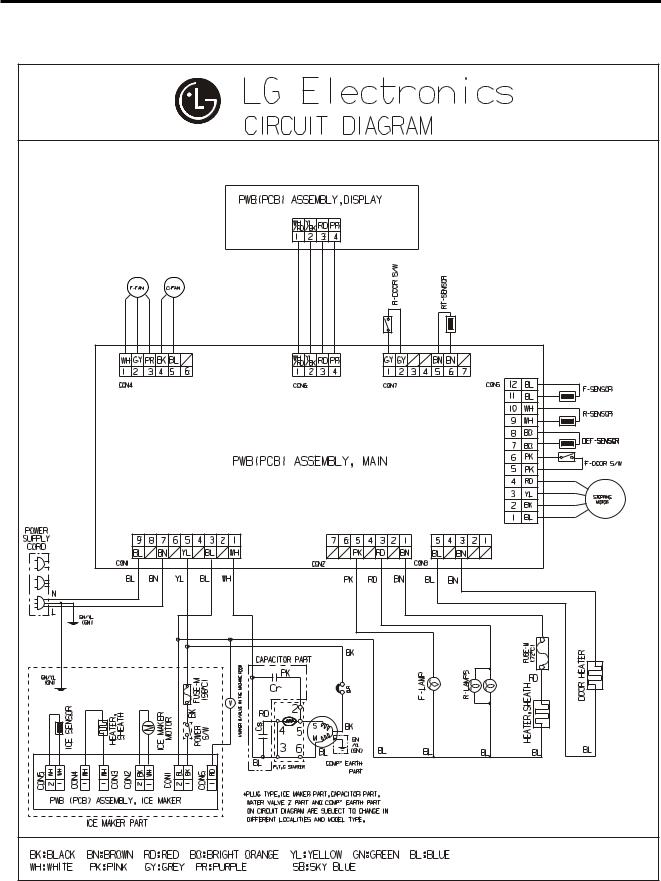
5. CIRCUIT DIAGRAM
PCB main, 6871JB1375
Air Damper |
Motor |
- 15 - |

PCB main, 6871JK1011
LG Electronics
CIRCUIT DIAGRAM
|
|
|
|
|
|
|
|
|
PWB(PCB) ASSEMBLY,DISPLAY |
|
|
|
|
|
|
|
|
|
|
|
|
||||||||||
|
|
|
|
|
|
|
|
|
BKBOBLSB |
WH/RDYL/BKRD PR |
|
|
|
|
|
|
|
|
|
|
|
|
|
|
|||||||
|
|
|
|
|
|
|
|
|
4 |
3 |
2 |
1 |
1 |
2 |
3 |
|
4 |
|
|
DOOR-R S/W |
|
|
PUMPS/W |
|
SENSOR-RT |
|
|
|
|
|
|
|
|
F-FAN |
|
|
C-FAN |
|
|
|
|
|
|
|
|
|
|
|
|
|
|
|
|
|
|
|
|
|
|
|
|||
|
WHGYPRBK BL |
6 |
|
|
BK BOBL SB |
WH/RDYL/BKRDPR |
|
GYGYYL RDBNBN |
|
|
|
|
|
||||||||||||||||||
|
1 |
2 |
3 |
4 |
5 |
|
|
1 |
2 |
3 |
4 |
1 |
2 |
3 |
|
4 |
|
1 |
2 |
3 |
4 |
5 |
6 |
7 |
|
|
|
|
|
||
|
CON4 |
|
|
|
|
|
|
CON6 |
|
|
CON6 |
|
|
|
|
CON7 |
|
|
|
|
|
|
CON5 |
12 |
BL |
F-SENSOR |
|||||
|
|
|
|
|
|
|
|
|
|
|
|
|
|
|
|
|
|
|
|
|
|
|
|
|
|
|
|
|
11 |
BL |
|
|
|
|
|
|
|
|
|
DISPENSER |
BASIC |
|
|
|
|
|
|
|
|
|
|
|
|
||||||||||
|
|
|
|
|
|
|
|
|
|
|
|
|
|
|
|
|
|
|
10 WH |
R-SENSOR |
|||||||||||
|
|
|
|
|
|
|
|
|
|
|
|
|
|
|
|
|
|
|
|
|
|
|
|
|
|
|
|
|
9 |
WH |
|
|
|
|
|
|
|
|
|
|
|
|
|
|
|
|
|
|
|
|
|
|
|
|
|
|
|
|
|
|
|
||
|
|
|
|
|
|
|
|
|
|
|
|
|
|
|
|
|
|
|
|
|
|
|
|
|
|
|
|
|
8 |
BO |
DEF-SENSOR |
|
|
|
|
|
|
|
|
|
|
|
|
|
|
|
|
|
|
|
|
|
|
|
|
|
|
|
|
|
7 |
BO |
|
|
|
|
|
|
|
|
|
|
|
|
|
|
|
|
|
|
|
|
|
|
|
|
|
|
|
|
|
|
|
||
|
|
|
|
|
|
|
|
|
PWB(PCB) ASSEMBLY, MAIN |
|
|
|
6 |
PK |
F-DOOR S/W |
||||||||||||||||
|
|
|
|
|
|
|
|
|
|
|
|
5 |
PK |
||||||||||||||||||
|
|
|
|
|
|
|
|
|
|
|
|
|
|
|
|
|
|
|
|
|
|
|
|
|
|
|
|
|
|
|
|
|
|
|
|
|
|
|
|
|
|
|
|
|
|
|
|
|
|
|
|
|
|
|
|
|
|
|
|
|
4 |
RD |
|
|
|
|
|
|
|
|
|
|
|
|
|
|
|
|
|
|
|
|
|
|
|
|
|
|
|
|
|
|
3 |
YL |
STEPPING |
|
|
|
|
|
|
|
|
|
|
|
|
|
|
|
|
|
|
|
|
|
|
|
|
|
|
|
|
|
2 |
BK |
MOTOR |
|
|
|
|
|
|
|
|
|
|
|
|
|
|
|
|
|
|
|
|
|
|
|
|
|
|
|
|
|
1 |
BL |
|
POWER |
|
11 10 9 |
8 |
7 |
6 |
5 |
4 |
3 |
2 |
1 |
|
|
7 |
6 |
5 |
4 |
3 |
2 |
1 |
|
|
5 |
4 |
3 |
2 |
1 |
|
|
|
||
|
BL |
|
BN |
GN/YLYL |
BL |
BK |
|
PR |
|
PK |
|
RD |
|
BN |
|
BL |
|
BN |
|
|
|
|
|
||||||||
SUPPLY |
|
|
|
|
|
|
|
|
|
|
|
|
|
||||||||||||||||||
CORD |
CON1 |
|
|
|
|
|
|
|
|
|
|
CON2 |
|
|
|
|
|
|
|
|
CON3 |
|
|
|
|
|
|
|
|||
|
BL |
BN |
GN/YLYL |
BL |
BK |
PR |
|
PK |
RD |
BN |
|
BL |
BN |
|
|
|
|
|
|||||||||||||
N |
|
|
|
|
|
|
|
|
|
|
|
|
|
|
|
|
|
|
|
|
|
|
|
|
|
|
|
|
|
|
|
L |
|
|
|
|
|
|
|
|
|
|
|
|
|
|
|
GN/YL |
|
|
|
|
|
|
|
|
|
|
|
|
|
|
(GN) |
|
|
|
|
|
|
|
|
|
|
GN/YL |
|
|
|
|
|
|
|
|
|
|
FUSE-M |
C)(98 |
|
(GN) |
|
|
|
|
|
|
|
|
|
|
|
||
|
|
|
|
|
|
|
|
|
|
|
|
|
|
CON5 2WH |
1WH |
ICE SENSOR |
1WH |
|
HEATER, |
SHEATH |
2BK |
M ICE MAKER |
MOTOR |
2BL |
POWERBK |
S/W |
1RD |
CON4 |
1 |
CON3 |
CON2 |
1WH |
CON1 |
1BK |
CON6 |
||||||
|
|
|
|
WH |
|
|
|
|
|
|
|
|
|
PWB (PCB) ASSEMBLY, ICE MAKER
ICE MAKER PART
V
ROOM |
CAPACITOR PART |
OLP |
V V |
|||
MACHINETHE |
Cr |
|
|
|||
|
|
PK |
|
|
|
|
W/VALVE IN |
RD |
4 |
2 |
|
|
|
I/MAKER |
Cs |
5 |
|
BK |
|
|
|
|
|
S |
|
|
|
|
|
3 |
M |
|
GN |
|
|
|
6 |
|
/YL |
|
|
|
BL |
BL |
(GN) BL |
BL |
||
|
P.T.C STARTER |
COMP' EARTH |
|
|||
PART
*PLUG TYPE,ICE MAKER PART,CAPACITOR PART, PWB(PCB) ASSEMBLY DISPLAY, PUMP S/W, DISPENSER W/VALVE PART AND COMP' EARTH PART ON CIRCUIT DIAGRAM ARE SUBJECT TO CHANGE IN DIFFERENT LOCALITIES AND MODEL TYPE.
DISPENSER W/VALVE PART |
R-LAMPS |
F-LAMP |
|
BL |
BL |
FUSE(72 M-C)
M-C)
RDHEATER,SHEATH 



BL
HEATERDOOR
BL
BK:BLACK BN:BROWN RD:RED BO:BRIGHT ORANGE YL:YELLOW GN:GREEN BL:BLUE
WH:WHITE PK:PINK GY:GREY PR:PURPLE |
SB:SKY BLUE |
- 16 -

6. TROUBLESHOOTING
6-1 COMPRESSOR AND ELECTRIC COMPONENTS
1
2
3
4
Power Source.
Check
Check resistance
resistance of of motor
motorpressorc.
compressor.
.
Check resistance of PTC-Starter.
Check OLP.
|
|
Remove PTC-Starter |
|
(Rated voltage |
YES |
|
|
|
from compressor and |
|
±10%)? |
|
2 |
|
|
|
|
|
||
|
|
measure voltage |
|
|
|
|
|
|
|
|
|
|
|
|
|
between Terminal C of |
|
|
|
|
|
|
compressor and |
|
|
|
|
|
|
terminal 5 or 6 of PTC. |
|
|
|
|
|
YES |
|
5 |
No voltage. |
OLP disconnected? |
Replace OLP. |
|
|
NO |
Check connection |
|
|
|
condition. |
|
 Reconnect.
Reconnect.
|
Applied voltage isn't |
|
Advise customer that |
|
5 |
|
in acceptable range. |
|
power supply needs to be |
|
|
|
(115V ±10%) |
|
checked by an electrician. |
|
|
|
|
|
|
|
|
Check the resistance between M-C, S-C and M-S in motor compressor. Check each pin to ground.
Check resistance of two terminals in
PTC-Starter.
The resistance between pins should be between 1 and 50 ohms. The resistance to
|
|
ground should be infinite. |
|
3 |
|
|
|
|
|
Open or short |
Replace |
|
|
|
or short to |
compressor |
3 |
4 |
5 |
|
ground
Refer to Page 13.
Check resistance of two |
|
|
Refer |
to Page 13. |
terminals in OLP. |
|
|
||
|
|
|
|
|
|
|
|
|
|
|
|
|
|
|
Check
5
starting state.
|
|
Check the power supply |
|
Supply |
YES |
Did |
YES |
|
Compressor |
|
|
|
|
|
under load. |
|
voltage rating |
|
compressor |
|
|
is OK |
|
||
|
|
(Compressor attempting |
|
with ±10%. |
|
start? |
|
|
|
|
|
|
|
|
|
|
|
|
|
|
|
|
|
||
|
|
to re-start after being off |
|
|
|
|
|
|
|
Replace the |
|
|
|
|
for 5 minutes). |
|
|
|
|
|
|
|
|
|
|
|
|
|
|
|
NO |
|
compressor |
|
||||
|
|
|
|
|
|
|
|
|
|
|||
|
|
|
|
|
|
|
|
|||||
|
|
|
|
|
|
|
|
|
|
|
|
|
 1
1
NO
- 17 -
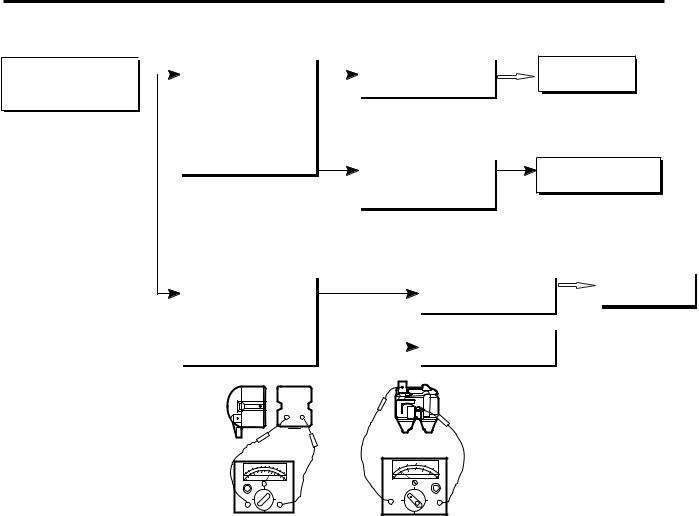
6-2 PTC AND OLP
Normal operation of compressor is impossible or poor.
|
|
Separate PTC-Starter |
|
Observation value is |
|
|
|
|
from Compressor and |
|
115V/60Hz : 6.8 ? ±30% |
|
|
|
|
measure resistance |
|
at room temperature |
|
|
|
|
|
|
|
|
|
|
|
between No. 5 and 6 |
|
|
|
|
|
|
|
|
|
||
|
|
of PTC-Starter with a |
|
|
|
|
|
|
Tester. |
|
|
|
|
|
|
(Figure 19) |
|
|
|
|
|
|
|
|
The resistance value |
|
|
|
|
|
|
is 0 ? (short) or |
|
|
|
|
|
|
8(open). |
|
|
|
|
|
|
|
|
|
PTC OK
Replace PTC-
Starter.
|
|
|
Shows continuity |
|
|
|
|
|
Separate OLP from |
|
Check another |
|
OLP OK |
||
|
compressor and check |
|
|
|
|||
|
|
|
electric component. |
|
|
||
|
resistance value between |
|
|
|
|
|
|
|
two terminals of OLP with a |
|
|
|
|
|
|
|
tester. |
Open |
|
|
|
|
|
|
(Figure 20) |
|
|
|
Replace OLP. |
|
|
|
|
|
|
||||
|
|
|
|
|
|
|
|
6 |
5 |

 ?
?
Figure 19 |
Figure 20 |
- 18 -
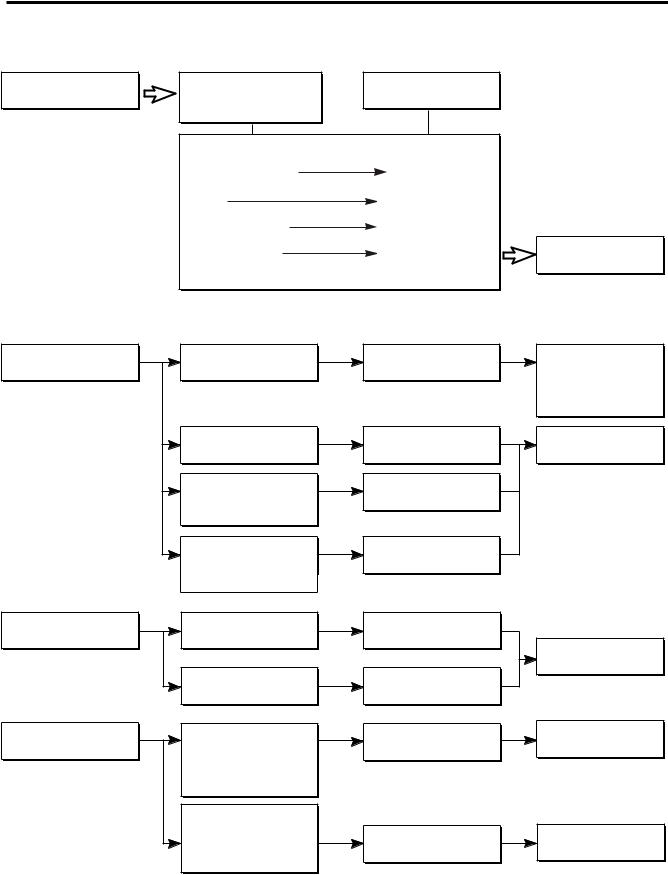
6-3 OTHER ELECTRICAL COMPONENTS
•Not cooling at all
Compressor doesn't run .
Check for open short or
Cause
incorrect resistance readings in the following components
|
a. Starting devices |
Short, open, or broken. |
|
|
b. OLP |
Poor contact |
|
|
or shorted. |
|
|
|
|
|
|
|
c. Compressor coil |
Coil open or shorted. |
|
|
d.Wiring harness |
Poor contact |
Replace |
|
|
or shorted. |
indicated component. |
•Poor cooling performance |
|
|
|
Compressor runs |
Check starting |
Low voltage. |
Advise customer that |
poorly. |
voltage. |
|
the power supply |
|
|
|
needs to be checked |
|
|
|
by an electrician. |
|
Check voltage at |
Poor or broken or |
Replace |
|
starting devices. |
open contact. |
indicated component. |
|
Check current flowing |
Shorted. |
|
|
In run winding of |
|
|
|
Compressor. |
|
|
|
Check rating of OLP. |
Lack of capacity. |
|
|
OLP: 4TM293RFB |
|
|
|
Temp. 130°C |
|
|
Fan motor doesn't run.
Heavy frost buildup on evaporator
Check wiring circuit. |
Wire is open or |
|
shorted. |
||
13 - 15 V |
||
|
Replace |
|
|
indicated component. |
|
Check Fan Motor . |
Coil is shorted |
|
or open. |
||
|
Check current flow in |
Open. |
Replace |
the following |
indicated component. |
|
components: |
|
|
Sensor |
|
|
Fuse-M |
|
|
Check resistance flow in |
Open. |
Replace |
the defrost heater. |
defrost heater. |
|
|
|
- 19 -
